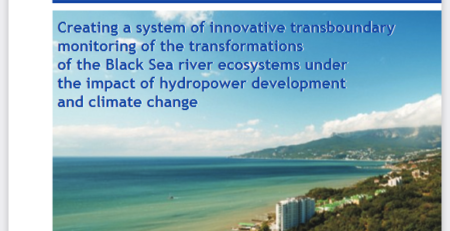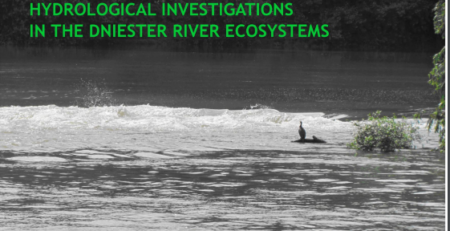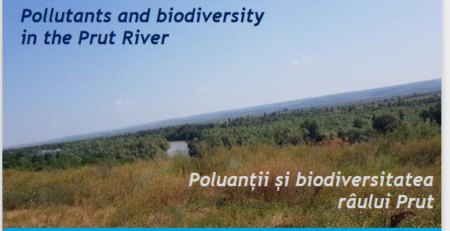A knowledge transfer workshop on the reduction of freshwater flow in the Black Sea under the effect of hydropower constructions and climate change
During 12-14 of December, 2019 the Ukrainian Scientific Centre of the Ecology of Sea (UkrSCES) brought together members of HydroEcoNex team (Institute of Zoology, International Association of River Keepers „Eco-Tiras” and Hydrometeorological Centre of Black and Azov Sea) as well as representatives from other institutions (Odessa regional administration, Odessa State Environmental University, Odessa National University, Lower Dniester National Nature Park, Biotiks South, Union of Morenists) in a knowledge transfer workshop dedicated to the reduction of freshwater flow in the Black Sea under the effect of HP and climate change, which was organized within the BSB165, HydroEcoNex project.

Reprezentatives of Channel 7 news took part in the event taking a video reportage, including an interview from Elena Zubcov, the project manager of HydroEcoNex project from the Institute of Zoology, corresp. Member of the Academy of Sciences. The event can be found on the following link:
The director of UkrSCES, Dr.Victor Komorin welcomed the participants and introduced the scope of the UkrSCES – investigation and protection of water resources, implementation of European Directives – Water Framework Directive, the mechanisms of managing water resources as well as undertaking complex investigations – on phyto- and zooplankton and more recently on dolphins. A recent interest of the institute is to increase the skills and knowledge on the monitoring of fish, part of the expertise they believe will get from HydroEcoNex project as well as other projects. The director also expressed his hope that Hydroeconex project will come with new recommendations on water management and improvement of the protection of water ecosystems, which are under pressure of natural and anthropogenic factors.
The project coordinator and head of the Department of Marine Hydrobiology of UkrSCES, Dr. Svetlana Kovalishina, welcomed all the participants, overviewed the agenda and the need of the workshop topics and also presented the participants of the HydroEcoNex team. She also expressed the deepest sorrow for the loss of colleague researchers from the Institute of Marine Biology and called the participants for a minute of silence to remember those who lost their lives in the fire.
The first speaker, Dr. Oleg Grib, from Odessa State Environmental University delivered a presentation on physico-chemical water quality parameters as well as the relationship between water flow and water surface slope of Lower Dniestr. In accordance to the average values of water quality indices of all investigated water bodies of the lower Dniester River, corresponded to the second class, 2 categories “very good”, the degree of pollution is “pure” and the trophic status – “mesotrophic”, by saprobability – “α-oligosaprobic”. However, if take into consideration the worst values of the indicators then the ecological status corresponds to the V class, 7 categories, – “very bad”, the degree of their pollution – “very dirty”, the trophic status is “hypertrophic”, the saprobity – “polysaprobic”.
The relationship between water flow and water surface slope are important for implementing prompt measures to warn the population and the authorities about potential flooding or considerable low water levels under the conditions of impact from hydropower. On Dniester river, the variations including those caused by wind, the water level and runoff depends not only on the water use but also on the slope of the water surface. The effect of wind on the variability of the water level does not make it possible to construct a unambiguous relationship between flow and water levels. The research allowed to determinate the daily water flow rates at the mouth of the Dnister River which can be quickly determined using data on daily water levels and water surface biases in the area between measurement points at village Troiktskoie and Mayaki.
Prof.Elena Zubcov, asked the opinion of the speaker in regard to the lack of water in Moldova, which occur on the sector from Naslavcha to Kamenka. Mr. Grib replied that he did not encounter such cases in Ukraine and would be nice to document such cases and measure it instrumentally. She mentioned about the impact of hydropower constructions on dynamics of main ions and the stock of suspended particles in the Dniester river. In the past, a proportional ratio of sodium to chloride anions was characteristic for the Dniester river. In the last 10 years, an increase in sodium concentrations was recorded, but not for chloride anions, which suggest about a replenishment of river water reserves from the upper horizons of groundwater. If in the 70-80 ‘years of the last century sand, sand-pebble and sand-silt sediments predominated in the Dniester river and Dubasari reservoir, and black and gray clay silts were noted only in places with wastewater discharge (for example downstream the treatment facilities of Ribnitsa, at Goieni river banks zones with slow flow, near Iagorlik with slow water flow and in a small area downstream the confluence of the Byk tributary), today the gray and black silt sediments are spread all over the river.
Dr. Volodimir Ukrainskii, the member of UkrSCES team in his presentation, mentioned about the variability of the maximum monthly flow of Dnister river from the year 1947 – to the present day, related to the construction of hydropower complex. Previously, the Dnestrovsk reservoir was used to prevent droughts and floods, which however is not anymore. One must recognize that currently the Dnestrovsk complex is only used for generating energy, thus transforming the water of Dniester river into a technical water with less and less biodiversity and poorer ecosystem functions. The monitoring which is carried out does not consider the changes which occur at ecosystem level, on the destruction and production process, the main function of river auto-purification and auto-restoration. We, as researchers need to combine our forces together to reveal these indicators and convince the decision makers about the need to do something about the Dniester river.
In the presentation delivered by Dr. Eduard Onishchenko, the member of Hydrometeorological Centre of Black and Azov Seas (HMC BAS), it was reflected that the statistical analysis of the Dniester flow before and after the construction of the Dniester Hydropower Complex, clearly showed the impact of the created reservoirs, both on the total annual volume of the river flow and on its seasonal and monthly annual distribution. The accumulation of runoff in the reservoirs of hydropower complex reduced its annual volumes by more than 10% at the river transect Bender and almost 40% at the river transect, Mogilev-Podolsk. As a result, the role of the upper part of the Dniester basin , which provide a 4/5 of the annual drainage of the Dniester River, as a whole, has dramatically increased, thus, confirming the urgency of the problem of preserving the ecological functions of this upper part of the basin. The regional projections of potential climate change in the Black Sea coastal zone of Ukraine based on climate change scenarios indicate changes in air temperature and precipitation during 2021-2050 and 2071-2100, which could be of weak, moderate or strong intensity, which could add to the negative impact on river ecosystems.
The coordinator of the HydroEcoNex team of HMC BAS, Dr. Aleksandr Matygin indicated that in order to calculate the hydropower impact on local climate, an electronic database was created on hydrometeorological observations on rapid assessments, average daily and average annual values of the parameters of the atmosphere and the Dniester River from the moment of the station’s operation to the present. The database contains data of weather stations and hydropower stations that are located in the Dniester River basin, both in the zone of near the built Dnestrovsk reservoirs, and on the territories located at a certain distance from them. Such database will allow to calculate the changes over three time intervals: from the beginning of the observation to 1954, from 1954 to 1986 and from 1986 to 2018.
The member of UkrSCES HydroEcoNex team, Tatiana Chujekova, made an overview on existing computer programs on data processing on water quality and modelling on freshwater ecosystems, which could be also useful for HydroEcoNex project. Some examples were given on data processing, were the researchers can make different calculations and modelling, however this require basic programming knowledge – R language. Other possibilities to process the data, without the need for programming are presented on the EU website http://fis.freshwatertools.eu. Also researchers can find useful information on the Freshwater Information Platform, which is a portal with database on freshwater biodiversity, maps and atlases. Calculation of various hydrobiological indices can be carried out using the programs Asterics or Aquatox.
Bo Libert, the external consultant of HydroEcoNex Project of International Association of River Keepers “Eco-Tiras” presented the first draft of the Strategy of bilateral cooperation on joint monitoring of transboundary rivers affected by hydropower” which is foreseen to be developed and delivered to the decision makers within the HydroEcoNex project. He raised some important questions on the strategy such as for whom is the strategy developed, how can be the stakeholders be involved, what are those ”new and innovative approaches to monitoring”, is there a case to separate between hydropower monitoring and general monitoring? He asked for the feedback from the participants on what can be added and what can be excluded from the strategy.
Elena Zubcov Elena Zubcov mentioned that the main objective of the project is to propose ecological indicators for estimating the influence of hydroelectric plants on the river ecosystem and the ecological as well as methodological aspect of evaluating these changes shall come as a central topic of the strategy. It is necessary to decide together which indicators to include in the strategies to be accepted be the decision makers. Legal and legislative aspects are Ok, but we are environmental researchers and these issues should reflect the planned strategy.
Ilya Trombitsky, the coordinator of Eco-Tiras proposed to include to the Strategy the necessity of joint monitoring of the parameters which are usually indicated by researchers as HPP impact consequences and also noted that indeed at this stage the information for this section is not sufficient since there is still work to be done such as assessing the impact on ecosystem services; however it would be important to add this more detailed assessments in the Annexes and more discussed will follow after this discussion.
The workshop was conducted back to back to the 3rd Steering Committee Meeting, where the state of financial reporting of each partner and main aspects of the financial and narrative interim report cooperation and sharing of information were discussed. The project manager, Elena Zubcov described briefly about the monitoring visit carried out by JTS and MA representatives of JOP BSB programme. Also an overview of the procedures for filling in the main parts of the financial and narrative reports were presented by Elena Zubcov and Nadejda Andreev. All partners shared their views and problems which appeared while filling in the narrative reports, the tasks of controllers and procedures of expenditure verification. Some questions still need to be clarified as regarding the description of the activities, procedures for the registration of the controller into the eMS system as well as the list of the attached documents. The project manager highlighted the importance to add the project stamp on each of the invoices, including the road sheets. LP mentioned that the IZ team will provide assistance in accordance to need so thus to finalize the report in time.












Leave a Reply
You must be logged in to post a comment.